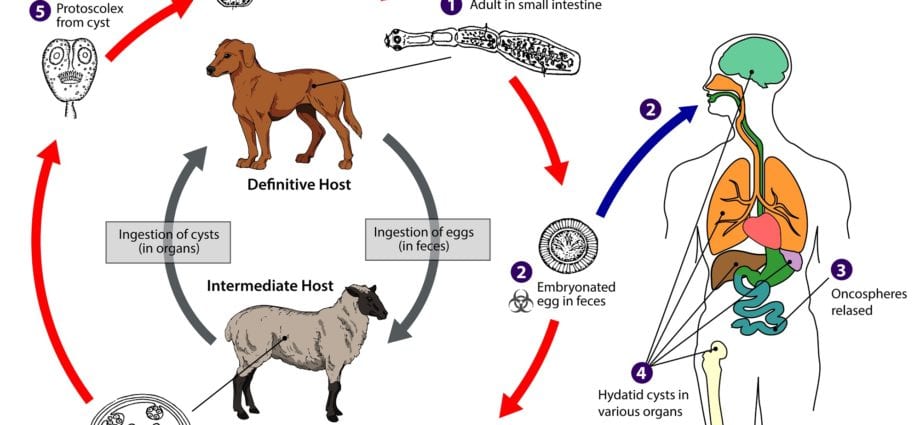Contents
General description of the disease
This is a parasitic disease, during which cysts form in the lungs, liver, bones and other organs.
Causative agent – Echinococcus in the larval stage.
Transmission mechanism – livestock eat grass that contains echinococcus eggs. The animal becomes infected, a person slaughters it for meat, the dog eats infected meat (thereby being a carrier of parasites), is emptied (ripe eggs are excreted in the dog’s feces). They get to humans through direct contact with a sick animal, when picking berries, drinking water from springs and springs.
Echinococcosis proceeds in 4 stages:
- the first stage is latent (the period of time from the ingress of the helminth egg to the appearance of the first signs);
- in the second stage, disorders of a subjective nature already begin;
- the third stage is characterized by the manifestation of objective signs with a pronounced character;
- the fourth stage is the stage of complications.
Symptoms appear depending on which organ or part of the body is affected by the worm. Often, the disease can proceed for many years without making itself felt.
In echinococcosis abdominal the course of the inflammatory process is noted, in which there is severe pain in the peritoneum, the pressure decreases, the patient begins to fever, the muscles of the anterior abdominal wall are stressed.
When echinococcus is affected by the brain, the symptoms manifest themselves in 2 types: hypertension syndrome (the presence of headaches, seizures of epilepsy, impaired visual function, vomiting and dizziness), in the form of focal signs (convulsive seizures with further paresis of those limbs where they passed, begins delirium, there is a feeling of fear, depression, depressive states).
When struck gallbladder an infected person begins hepatic colic, jaundice, vomiting, fever, clogged bile ducts, hepatitis and cholecystitis may develop.
Most rarely, echinococcus affects bones… In this case, cysts develop in the bone marrow cavity. In places of their appearance, bone erosion begins and fractures occur.
When the helminth gets into lungs (to the extent that it grows), severe pains in the sternum begin, at first a dry cough appears (then phlegm begins to stand out, often with blood clots). When large cysts are reached, the chest is deformed, shortness of breath begins, and anaphylactic shock may occur.
Most common echinococcosis of the liver… Cysts can grow not only on liver cells, but also grow into the choleretic tract and the peritoneal region. The first sign is considered to be heaviness in the hypochondrium on the right side. With the growth of the cyst, a liver abscess occurs, which (if opened) will develop into peritonitis or purulent pleurisy, cholangitis.
In echinococcosis kidneysthe left kidney is mainly affected. Symptoms include general intoxication of the body, malaise, weight loss, allergic reactions (especially the skin is itchy), urine becomes cloudy and flaky, renal colic may begin, urinary excretion may be delayed.
Increase spleen and its atrophied tissues (the spleen resembles a bag, it was given the name “echinococcal sac”) speaks of the defeat of the spleen by helminths.
The rarest type of this disease is echinococcosis of the heart… Clinically manifests itself in the form of heart failure, tachycardia, cardiac obstruction. On this basis, myocardial infarction may occur.
When the parasite enters the spinal cord, paresis and paralysis of the limbs begin, problems with the functioning of the pelvic organs. For the longest time, it does not appear in any way (until the cysts grow). At the beginning of the progression of the disease, patients noted pain in the lower and upper extremities, chest girdle pain.
Useful products for echinococcosis
- spices: horseradish, mustard and its seeds, ginger, cinnamon;
- greenery;
- raw pumpkin seeds, nuts;
- lemon;
- dairy;
- pickled vegetables.
Traditional medicine for echinococcosis
With this disease, traditional medicine is effective only in cases where the helminth is in the embryo stage or if the cyst growth process has just begun.
To get rid of the parasite, you need to drink decoctions of wormwood, tansy, cloves, ginger and lemon peel (dried ginger root or lemon peel is crushed into powder, a teaspoon of the resulting powder is taken and dissolved in 50 milliliters of water or milk, drunk on an empty stomach). To get rid of echinococcus every day for 15 days, you need to drink a pea of black pepper. Drink daily water made from crushed lemon, two heads of garlic, a tablespoon of honey per liter of water (single dosage – 30 milliliters). Apply any remedy to the fasting early in the morning (at least 30-40 minutes before breakfast).
Dangerous and harmful products with echinococcosis
You should limit the use of butter (up to 20 grams per day) and salt (up to 30 grams).
The “forbidden list” for gastritis includes products containing oxalic acid, extractives, essential oils, which activate the secretion of secretory substances by the stomach and stimulate increased work of the pancreas.
Attention!
The administration is not responsible for any attempt to use the information provided, and does not guarantee that it will not harm you personally. The materials cannot be used to prescribe treatment and make a diagnosis. Always consult your specialist doctor!










